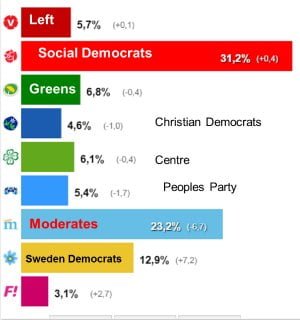Eight years of cuts, privatisations and continuous high unemployment have finally led to the fall of the right-wing government in the recent Swedish elections, held on 14th September. But despite the dissatisfaction with the right-wing policies, neither the Social Democrats nor the Left Party proved able to channel the anger felt in society.
Eight years of cuts, privatisations and continuous high unemployment have finally led to the fall of the right-wing government in the recent Swedish elections, held on 14th September. But despite the dissatisfaction with the right-wing policies, neither the Social Democrats nor the Left Party proved able to channel the anger felt in society.
The Social Democrats are now reaching out to right-wing parties to be able to form a government – and the Swedish Democrats are getting a more pivotal position in parliament. Anything could happen now. We will most probably see the most unstable minority government in Swedish history.
The conservative party Moderaterna fell from 30 percent to 23.2 percent, while the three smaller right-wing parties also lost support. But the Social Democrats together with the Left Party and the Greens only got a combined vote of 43.7 percent against 39.3 percent for the right wing! At the same time, the racist right-wing extremist Sweden Democrats got an additional 12.9 percent. As it is politically unfeasible for the right-wing to form a government with the reviled Sweden Democrats, their prime minister resigned and it is now up to the Social Democrats to form a government with a weak base of support in parliament.
This shows that Sweden is catching up with the unstable political situation in other countries, which is the result of the crisis of capitalism. The traditional left and right-wing parties are in crisis, since an increasing amount of people are losing their confidence in the establishment, while none of the left parties stand sufficiently to the left to be able to channel the anger against the system. What we are witnessing is the beginning of a deep crisis for bourgeois democracy in Sweden.
The failure of Social Democracy
 When the right won the elections in 2006, they promised to get rid of mass unemployment. Some workers voted for the conservative Moderaterna (the main bourgeois party) in 2006 and 2010, since they promised to provide more money to spend through less taxation. Through faster privatisations of the welfare system, and lower taxes for the companies and the rich, they have maintained high profits for the companies. They were hoping and claiming that this would stimulate them to invest and to hire more people. Through attacking unemployment benefits, health insurance, and a worsened labour legislation, they have tried to force people into taking whatever low wage job they can get – with whatever conditions they can get. But unemployment still remains high at 7.9 %.
When the right won the elections in 2006, they promised to get rid of mass unemployment. Some workers voted for the conservative Moderaterna (the main bourgeois party) in 2006 and 2010, since they promised to provide more money to spend through less taxation. Through faster privatisations of the welfare system, and lower taxes for the companies and the rich, they have maintained high profits for the companies. They were hoping and claiming that this would stimulate them to invest and to hire more people. Through attacking unemployment benefits, health insurance, and a worsened labour legislation, they have tried to force people into taking whatever low wage job they can get – with whatever conditions they can get. But unemployment still remains high at 7.9 %.
The elections should therefore have meant an easy victory for the labour movement, but the Social Democrats only barely increased their vote by one percentage point compared to the elections in 2010. The reason for this is to be found in their right-wing policies, which have been about moderating expectations on what changes would be possible after the elections. The tax reductions for the bourgeoisie would remain, and their main criticism against the right was that they had been to “irresponsible” with their tax reductions.
They also distanced themselves from the Left Party, and now have also made clear that they won’t collaborate with them in government. Instead they have time and time again spoken about the need for an agreement between the left bloc and the right bloc, and reached out during the entire election campaign to both the Centre Party (the old peasants’ party) and the People’s Party (the liberals). It is already clear that this right-wing orientation is unpopular, and the Social Democratic party leader Löfven, will only succeed in weakening the Social Democracy even further. But leaders like him would rather sacrifice their party than take on the necessary struggle against the capitalist system.
The result is that few felt that there would be any real difference with the Social Democrats. This, combined with the anger towards the bourgeois government, could not result in anything but that left-wing voters would shun the Social Democrats and right-wing voters would shun the Moderates. Only through presenting a left-wing alternative to the policies of the right, would the Social Democrats have been able to regain their historical support, which was closer to 45% than to 30%.
Why is the Left Party not increasing its share of the votes?
The Left Party should in this context have won much more support in the elections, but they barely got a better result than they did in 2010. A lot of people are searching for a radical option to the left. We are witnessing a radicalisation in society, especially amongst the youth, which has been shown, among other things, by the demonstrations against racism and fascism during the last year. The Left Party should have stood in the forefront of this struggle, and did what they could to participate, lead and support the struggle.
Instead they have done the exact opposite. The party leadership has consciously distanced itself from the radicalisation by suspending members who have been seen as “inconveniently” radical in their anti-fascism. During the struggle before the EU-elections, the Left Party leader Sjöstedt, said that it was wrong to try to hinder the demonstrations of the Swedish Democrats – which he later was forced to take back and apologise for.
Generally, the party has remained passive. They haven’t intervened systematically in the big demonstrations that have been taking place during the last year, but rather it has been the decision of isolated members, or in the best cases branches and districts, if they wanted to participate. The Left Party in Malmö has, for example, been exemplary in its active participation in these demonstrations, and has also thereby increased in members and in its share of votes.
More and more people are questioning the capitalist system and looking for an option. Many are also suspicious of the establishment, of bourgeois democracy and its institutions. The Left Party therefore had a very good base to build on and to significantly increase its share of the votes, if they had put forward socialist policies. But the party leadership is regrettably increasingly keen to present themselves as part of the establishment – as good politicians who assumes responsibility for the Swedish economy. They are neither presenting themselves as a party for workers, which consistently represents the workers and their struggle, nor a party for radical youth who want to fight to change society.
A smaller copy of the Social Democrats?
Even though they have many individual radical demands, the party has been presenting itself as a party which stands only slightly to the left of Social Democracy – but a party which, in essence, is not different. Despite the slogan of “not for sale”, which suggested that the Social Democracy was for sale, they have insisted that they want to take part in a government of the Greens and the Social Democracy. In the election debates they have said that they are prepared to compromise on their demands in order to be able to take part in a government.
They have focused on the question of banning the profit-motive from the welfare state, which of course is important, but they have done it to such a degree that they have almost come across as a single-issue party. They have made it seem as if a prohibition of profits in the welfare state would be a magical solution to all questions, instead of saying that the issue is just a part of the struggle against the profit-motive as a whole and capitalism as a system.
The party leadership has painted all the reforms it has been pushing – the six-hour working day, the right to full-time employment, banning manpower agencies – as something which “everyone” would gain from, except possibly for a small number of venture capitalists. They have tried to make it look as if their policies would be “good for the economy”, or in other words good for Swedish capitalism. But workers are not stupid; on the contrary they understand very well that many of the demands pushed by the Left Party will not be accepted very easily. The reason for this is not as the party leadership thinks, because they would “take time” to put into practice. It is not the negotiations in parliament that are decisive, but the class struggle on the streets and in the workplaces.
The reason why it would be difficult is because you cannot win many concessions in a situation like the current one without a fierce struggle against the bourgeoisie. The capitalists are firmly determined to maintain their high profits and their “competitiveness” by pressuring the working class. The Left Party should have explained the need to fight against the bourgeoisie in order to carry out socialist policies. They would have had to criticise the passivity and rightward turn of the Social Democracy.
Feminist Initiative and the Greens
The petty-bourgeoisie party Feminist Initiative did not reach the 4 percent threshold to get into parliament. However, with their 3 percent they seem to have made the impression on many that they are the new “radical left-wing party”. In reality they are nothing of the sort. They are, if anything, even more willing to compromise with the right wing. They lack any base in the working class and – just like the Left Party – do not even have socialism inscribed in their party programme. Their goal is only, as their representatives have stated, “a global capitalism with a human face”. Therefore, their demands for reform will have to take second place to what they think is more important, getting representatives from different oppressed groups to get so-called “influence”. In the municipalities where they did get in, they will show that they are as much as part of the establishment as the other parties.
The Greens used to be able to appear like something of a left-wing party, but has in the recent period have moved to the right. Despite the fact that their membership voted to the left of and against the party leadership at their party congresses, the party leadership has moved closer to the right wing in the Social Democrats. They have also made deals with the right-wing government about REVA [campaign against illegal immigration], which provoked a scandal last year when police carried out racially based harassment of people in the Stockholm metro in their hunt for supposedly “illegal immigrants”. They can no longer hide behind a left veneer, but are increasingly appearing as the right-wing party that they really are. This is the reason for their low showing of just 6 percent.
The Left Party would no doubt win over many, if not all of the left-wing voters of the Feminist Initiative, the Social Democrats and the Greens, if they presented socialist policies and fought for them. This is what the party needs to understand in the coming period if it is to really become a serious opposition to the right-wing policies presently being carried out.
The rise of the Sweden Democrats
The Sweden Democrats (SD) are an extreme right-wing, racist party, which has its roots in the Swedish fascist movement. Recently they have tried to clean up their image and distance themselves further from their fascist past, and have expelled anyone caught making overtly racist statements. While this has been largely a charade for the sake of the media, it demonstrates that there simply is no room in Sweden for an openly racist party.
All this, however, has prepared the grounds for their successes in this election, where they doubled their vote from 5.7 to 12.9 percent. That they were able to get such a good result is mainly due to right-wing voters moving away from the conservative Moderaterna because they have been seen as moving too far to the middle ground. The former right-wing Prime Minister Reinfeldt gave a hypocritical speech where he tried to play both sides of the field. He said that we need to “open our hearts” to people seeking asylum, but also hinted that we will have to accept a worsened welfare state because of the “costs” of immigration. This manipulative statement only served to further increase the support for the SD.
It is not the case that 13 percent of the Swedish population is racist. According to the Eurobarometer from 2011, 81 percent of the population in Sweden thinks that immigration serves to enrich the country, and a staggering 95 percent defends the right to asylum. Most workers who vote for the SD are not racist. They do not believe that immigrants are in any way inferior, they do not want people to die in war-zones, nor do they wish for immigrants to be sent back or for immigration to cease.
Many do feel, however, that all the promises of the politicians about more jobs are false, and correctly expect even worse days in the future. Lacking any better alternative, they incorrectly hope that there will be more jobs if one “simply” reduced immigration for a period. If workers are not offered the possibility of expressing solidarity in a common struggle – where everyone can gain by struggling for a different society – then many will draw the conclusion: “me first, my family first, my group first”. The logic is reactionary and twisted, but it is not the same thing as hatred for foreigners. The number of workers voting for the SD should not be exaggerated. Only about 11 percent of blue-collar workers voted for the SD, which is less than in 2010.
Just like in the rest of Europe there is an increased polarization between right and left. The crisis is leading to a questioning of the establishment and a reduced support for the traditional left and right-wing parties, while the parties that are further to the left – and to the right – gain increased support. For example, the Greek PASOK (socialist party) has been completely decimated, while the left-wing party SYRIZA, which appeared to be taking a stand against the austerity policies, has grown from just 4-5 percent to being the biggest workers’ party with 27 percent of the votes in the last election. But if there is no clear alternative on the left, there is room for more extreme right-wing parties, who not only can attract right-wing voters, but also disappointed workers who could have been won to a radical programme.
The Sweden Democrats is a party of disappointment and pits worker against worker. But such a party is also highly unstable. They will only be able to keep their working class voters as long as there is no clear alternative to the left, and especially as long as they are not in power themselves, which would expose them as being part of the establishment. Nine times out of ten, when their vote has been decisive, they have voted with the right-wing in parliament.
The SD is one of the most hated parties in Sweden, with 49 percent saying they would vote against them if they could, and two out of three who think that they should be completely isolated politically. This is the reason the right-wing cannot form a government based on the support of the SD at this point – it would become the most hated government probably ever. But sooner or later the right wing will be forced to collaborate openly with the SD to form a government. In power, the SD would not be able to hide from their own policies, but would be exposed as the enemy of working people that they truly are.
The Left Party must stay out of government
Exactly which government we will get and which coalition of parties will govern during this period is impossible to say at this stage. Instability is the main feature of the current period internationally, and instability will no doubt be the main characteristic of Swedish politics in the near future. It looks probable, however, that we will start out with a government consisting of the Social Democrats and the Greens.
The bourgeoisie will put heavy pressure on all parties to form some kind of government with some semblance of stability – and they cannot have a government which cannot govern. For this reason they are currently putting pressure on the right-wing Centre Party and Popular Party to “open up” to collaborating with the Social Democrats. Scandalously, the main trade unions LO, TCO and SACO have all rallied behind this demand to get a “strong” government. As if a “strong” right-wing government would in any way benefit the interests of their members!
The fact that the right wing and the left wing are collaborating in parliament will undoubtedly strengthen the Sweden Democrats even further. The only thing that can slow their growth is if the Left Party were to put forward a consistently socialist programme. The party leader Sjöstedt has stated that as they have not been offered a place in the government they will not support it. It is absolutely correct to refuse to give even passive support to a government that will lean on the right wing and carry out the same policies as the previous government. The party must stand firm on this no matter what.
The right-wing parties and the Sweden Democrats can sabotage any attempt to carry out reforms using their majority. It is not excluded that before the end of this period we will see a right-wing government with the support of the Sweden Democrats. And considering its weak parliamentary position and the rightwards turn of the Social Democratic leadership, there can be no doubt that what is on the agenda is a policy of austerity.
Even if the Social Democratic leader Löfven were to come crawling on his bare knees with the threat that the government will fall if the Left Party does not support their budget, the Left Party must refuse! They must stand firm against policies of cuts and attacks against the working class – even if they were to get small concessions on this or that point. If the Social Democratic-led government falls, it will not be because of the Left Party. Put the blame where it belongs, on the shoulders of the Social Democratic leaders!
Lead the struggle against austerity
The Left Party must not vote for any right-wing policies, but consistently in all areas, municipalities, regions and in parliament, but stand as a hard-line working class party which exposes the political horse-trading that goes on behind closed doors, and which defends any and all gains made by the working class. They must present a very firm line with one demand after another on improved living conditions – not to sow any illusions that they will be passed in parliament, but as a call for workers and youth to organize and struggle around.
They have to participate in every demonstration and struggle and show that they are on the side of the youth and workers – against the fascists, the police and the right wing. “Line 17” who called the demonstration against the fascist sect “Party of Swedes” in Stockholm in late August openly called for help – and the Left Party should have responded. The party has almost one hundred years of experience organizing struggles against all the horrors of capitalism. Not to educate the youth on how to do this is a terrible waste. What was needed in all of last year’s demonstrations was an organized and coordinated leadership.
The party has to break with the politics of compromise and adopt a socialist programme. The bourgeoisie will not allow any policies of reform, but will organize class war against a left-wing government. That is why we must understand that the only way to change things is through mobilising and organizing youth and workers on the streets, in schools and in work-places. The Left Party has to explain that real welfare is only possible if capitalism is overthrown.
We must do what Lenin said: always tell the truth and show ourselves as being prepared to fight until the very end. And it is not through alliances with the rest of the political rabble that we will defeat the Sweden Democrats, nor will this be achieved by adopting the false slogan “we are the 87 percent” that some now counterpose to the 13 percent of the Sweden Democrats. The Left Party must show that it is the only real opposition and the only real anti-establishment party, by distancing themselves from all other parties in parliament.
We are living in what is most probably the worst crisis of the capitalist system in history. Thus far it has not hit Sweden that hard, but what is happening in Southern Europe is slowly but surely reaching Northern Europe too. Sweden, a country that is very dependent on its exports, will not be able to avoid the effects of the world crisis for very long. The present political crisis is an anticipation in miniature scale of what the crisis of the economy will look like. The future attacks that the bourgeoisie and its government will have to carry out against the working class will make the previous right-wing governments’ austerity look like child’s play.
Millions of people all over the world are questioning capitalism and looking for an alternative – and fighting for it. That struggle will sooner or later also reach Sweden. That struggle will be in vain, however, unless there is a party that can lead the way out of the chaos. The Left Party must aim to become that party.
We may not be able to win a majority for the cause of socialism today, but the crisis of capitalism will push more and more to draw increasingly radical conclusions. The Left Party must not stain its banners with betrayals and compromise for the sake of some ministerial positions or minor cosmetic concessions. Even now the potential is there to win more than a mere 6 per cent, not only as voters but as organized revolutionaries. The future has no place for cowardliness and vacillation. The only way forward is an irreconcilable struggle against the right wing and the capitalist system as a whole – a struggle for socialism!
- No support for the Social Democratic right-wing policies!
- The Left Party must stand on a socialist programme!
- Revolutionary struggle against the crisis of capitalism! Fight for socialism!
Avanti Editorial Board,
Swedish Section of the International Marxist Tendency
www.marxist.se






